Managing a football club is a tough job. You need to deal with all sorts of players, keeping a group of egos committed to playing for and with each other. Playing together in a squad requires a few members to often make sacrifices for the stability and success of the collective, and it is the manager’s job to coax these players to play out of their comfort zones.Often, this involves a change in playing position, the need arising because of reasons like injuries, suspensions or transfers. These changes are generally temporary in nature, with either a new signing for the position or the return of the incumbent player. Sometimes, however, the replacement turns out to be good enough to fill in for that role on a more permanent basis. Let’s take a look at a few players who have successfully adapted to a fullback position having begun their careers and trained at other positions.
#1 Kieran Gibbs
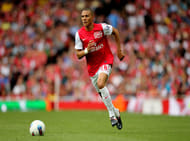
A swashbuckling left-back who is known to love to get forward, Gibbs, a product of Arsenal’s youth academy, was trained as a left winger on account of his great pace, crossing and shooting ability which he has displayed on a few occasions even as a fullback. Promoted to the senior squad at the age of 18, Gibbs failed to make an appearance in the first half of the 2007-08 season due to Alexander Hleb’s impressive form.
He was loaned out to Norwich, where he was tried out successfully as a left back, and it stuck. Gibbs was recalled to Arsenal and made 2 appearances before the end of the season in the League Cup. It was not until Gael Clichy’s sale to Premier League rivals Manchester City that Gibbs emerged as a left back of international quality. With his increased game time, Gibbs proceeded to silence doubters, who believed he didn’t have enough defensive discipline and was still struggling to adapt from his position as winger.
Gibbs made his international debut for England in 2010, and this year, is now thought of as England’s second-choice left-back behind only Leighton Baines from Everton. Gibbs has been a regular feature for Arsenal, beating off competition from Spanish international Nacho Monreal, who was signed in January 2012 as additional cover for the left back slot. Aged only 25 now and with possibly his best years of football ahead of him, Gibbs has the ability to match Nigel Winterburn, Ashley Cole and Clichy and go down in Arsenal history as one of their superior left backs.
#2 Domenico Criscito
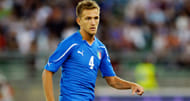
Although he began as a left-footed centreback at Genoa at the tender age of 16, having also been played as a left wingback in a latter spell, the former Juventus man is one of the leading left backs of world football. He is well-known for his versatility, even now having filled in as a left winger for Zenit on occasion. With boundless energy and the ability to play the striker through with either lofted or grounded passes, Criscito represents a complete package of attacking skills, while being defensively sound.
Criscito’s international career, though has been stop-start at best. He debuted for Italy in 2009 and featured in the 2010 World Cup too. After playing a role in their qualification for the Euro 2012 and being named in the 23-man squad, Criscito was dropped from the squad amidst match-fixing allegations being levelled upon him. Since then, he hasn’t made an international appearance so far. Currently plying his trade in the Russian Premier League under Andre Villas-Boas at Zenit, though, Criscito has had a fairly successful domestic career.
#3 Erik Durm
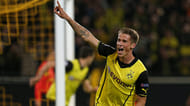
Durm graduated from the ranks of FC Reischweiler, a feeder club for the giants of the Ruhr Valley – Dortmund and Schalke. He was sold to Mainz at the age of 18, where appearing for their reserve team, Durm scored 13 goals in his second season in the Western League. This prompted a move from Dortmund in 2012, who signed him as a striker. Still too raw to feature in their first team, Durm played in the third tier of German football in Dortmund’s reserve team, but the goals dried up.
It was in the following season that Durm had the breakthrough of his career. Dortmund had one of their worst injury crises in the beginning of the 2013-14 season, with the entire backline of Lucasz Piszczek, Neven Subotic, Mats Hummels and Marcel Schmelzer injured. Klopp evidently saw something in Durm’s game that prompted him to shift Durm to the left back position. The rest, as they say, is history.
Durm put in such strong showings at his new position that season that he made 7 appearances in various friendlies in 2014 and edged out competition from various other German full backs, including the injury-plagued Schmelzer, to feature in Germany’s provisional 30-man, and eventually the final 23-man squad for the World Cup.
Although he did not feature in any of Germany’s games, warming the benches, it represents a great success for a player who was thought of as Lewandowski’s eventual replacement at just the start of the season. Now predominantly a left back, Durm has appeared in most of Dortmund’s games this season.
#4 Lukasz Piszczek
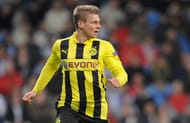
In the U-19 European championships of 2004, a young Polish player finished joint-top scorer, and he seemed to have a good future as striker.
Recognized as one of the world’s top right backs today, Piszczek played in a variety of attacking positions with both Hertha Berlin and Zaglebie Lubin, including periods as striker, left and right winger. With the limited success that he enjoyed, however, he failed to nail down a starting berth. In the 2008-09 season, he was played at right back for the first time, but lost his starting berth to German international Arne Friedrich. Friedrich, however, shifted to the centre of defense in the next season with Piszczek being brought back to the starting XI as the right back.
Lukasz hasn’t looked back ever since, moving to Borussia Dortmund on a Bosman transfer the next season and playing an important role in Dortmund’s twin league victories in 2010-11 and 2011-12. Although he ended up on the losing side in the Champions League final at Wembley against Bayern in 2013, he established himself as an elite right back on the European scene.
Piszczek has been a Polish international at right back since 2007.
#5 Ignazio Abate
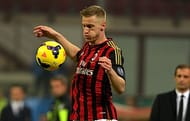
It is no surprise given Abate’s speed, crossing delivery and work rate that he used to be a wide midfielder earlier in his career. A product of the Milan youth academy, Abate spent his first 5 senior seasons with Milan out on loan at various clubs in Italy including Napoli, Empoli and Torino, in a period starting from 2004. Finally, in 2009, 23-year-old Abate was reclaimed by Milan for 2.55 million euros.
In the 2009-10 season, Abate was initially used by manager Leonardo as a right winger, with the departure of Kaka having left a gaping hole in midfield. With the progress of the season, however, Abate was brought deeper to be played as right back. He impressed the management staff so much that he was given an improved contract in the middle of the season. Ever since then, Abate has operated as right back quite successfully.
Even with the team falling to pieces around him and Milan having lost their previous continental and domestic glory due to the financial troubles of the Berlusconi family, Abate remains committed to the Milan cause. Abate made his international debut for Italy in 2011 and has featured in Euro 2012, the Confederations Cup 2013 and the World Cup 2014.
#6 Jordi Alba
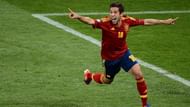
Trained as a left winger at Valencia and Barcelona, Jordi Alba alternated between winger and fullback on several occasions in his spell at Valencia. Initially played as a winger, he was quickly brought into defense in his first senior season as Valencia suffered a spate of injuries in defense. Jordi, therefore, played as a left-back in Valencia’s 2009-10 squad, alongside Juan Mata, David Silva and David Villa. In his second season, he battled with Jeremy Mathieu for a starting berth in the same position.
It was in his breakthrough, third season as a senior professional that Alba caught the eye, making his international debut in 2011. Playing as a left winger, Jordi Alba impressed his former bosses back at Barca, who signed him for 14 million euros at the end of 2011-12. With a goal in the final of the Euro 2012 to make it 2-0, Alba had displayed his ability in front of goal on one of the biggest stages in football.
A marauding fullback with great pace, a cutting edge and an eye for goal born out of training in midfield, Alba is a model left back and ranks among the world’s best, having been probably Barcelona’s most consistent player over the past 2 seasons, and beating off formidable competition in the form of Brazil international fullback Adriano Correia.
#7 Patrice Evra
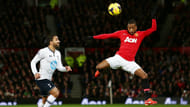
One of the most graceful players from recent times, Patrice Evra’s class on the ball is capable of causing even the most one-eyed barracker to burst into applause in admiration for the way he takes the ball past players and plays it into the box. A key member of Manchester United’s 5 league triumphs ever since he joined the club from Monaco in 2006, his 8 years at the club will always be cherished by all Manchester United fans.
Evra began his career as a wide forward or left winger. He had proven ability as a forward, but he just didn’t find the correct situation at a club as he went through many teams and trials. It was only at Nice that he started making regular senior appearance at 19, as a wide midfielder, or on some occasions as striker for their reserve team. Due to an injury crisis in the first team, he was called up to the squad.
A move to Monaco in 2002, playing under Didier Deschamps who had captained France to their World Cup win 4 years ago gave him greater stability. He adapted to the left-back role and was a regular starter as Monaco made a fairytale run to the final of the 2004 Champions League, falling at the final hurdle to Jose Mourinho’s Porto.
Evra secured a move to Manchester United in the January transfer window of 2006 on the back of consistent showings at Monaco. Initially struggling to cope with the pace of the Premier League, like counterpart Nemanja Vidic who joined him at the same time, Evra quickly came right up to speed, and for most of his Manchester United was, remained a top left back.
Evra made his France debut in 2004, and has represented them at their last 4 major tournaments starting with Euro 2008. Now playing for Juventus, Evra’s best days may be behind him, but he remains a competent professional even at the highest level.
#8 David Alaba
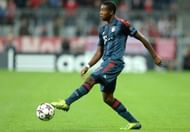
Widely acknowledged as the world’s top left back now, David Alaba is less than 3 years removed from being shifted to the left side of defense by Jupp Heynckes on a permanent basis. Even now, he plays as a defensive midfielder for his national team, Austria.
Alaba was recognized as a star in the making as he became the youngest ever player to appear for Bayern at just 17 years, 7 months and 8 days, coming on as a substitute in a German Cup match against Greuter Furth in early 2010. After a year with the first team, Alaba was sent to Hoffenheim on a 6-month loan in the January transfer window of 2011, where he gained valuable experience.
Under Jupp Heynckes, David Alaba was an increasingly important player in the 2011-12 season, eventually displacing Brazilian Rafinha from the first team. Alaba impressed a great deal in the Champions League semi-final but missed the final due to an accumulation of yellow cards. He came back next season stronger than before, and his desire to burst forward, overlapping Ribery on the left flank and attacking threat were a major factor in Bayern’s treble-winning season, and he was recognized among the world’s best with that season.
Alaba and Ribery combine to form one of the most deadly duos on the left flank, quite similar to the way Marcelo gallops forward to help out Ronaldo. Alaba is also a dead-ball specialist, scoring a number of free kicks and is Bayern’s default in-game penalty taker. Quite an adaptation!
#9 Fabio Coentrao
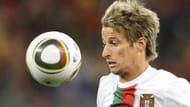
Fabio Coentrao is quite a versatile player, capable of playing at left back, left wingback, left winger and as a defensive midfielder. It was as a winger that he began his club career at Rio Ave in the Primeira Liga and earned the award for the Breakthrough Player of the Season aged 18.
Coentrao joined Benfica in 2007 but was unable to make an appearance for them in the stiff competition for places. Getting loaned to Zaragoza did not do much good as game time was hard to come by even there. A loan deal back at his youth club Rio Ave was more beneficial, and Coentrao began the 2009-10 season in much better form. He was shifted to left back for the first time in his career, and he responded in kind with consistent performances week in, week out.
He made his senior debut for Portugal as a left back having played at various junior levels as a winger, and cemented a starting berth in Carlos Queiroz’s plans for South Africa 2010. He started all 4 of Portugal’s games in the finals as Portugal were knocked out by eventual champions Spain in the round of 16. Another exceptional season with Benfica saw his transfer value skyrocket as Liverpool and Real Madrid came calling. A 30 million euro plus Garay offer for him meant that Coentrao was a part of Jose Mourinho’s Real Madrid squad.
Ever since, he’s faced stiff competition with Marcelo as both of them are recognized among the world’s class at the position. Coentrao is generally recognized as the more defensive of the two and is featured in games where Madrid feel the need for greater cover to their back 4. Coentrao started in Real Madrid’s Champions League final victory at the Estadio da Luz, the scene of his exploits with Benfica.
#10 Branislav Ivanovic
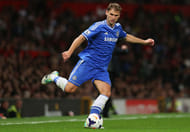
Branislav Ivanovic made his international debut, and still plays as centre-back for Serbia, now their captain. His time at Lokomotiv Moscow had marked him out as a tough, no-nonsense defender, and he arrived at Chelsea for a reported 13 million euros in January 2008. He failed to make an appearance that season however as he was out of match fitness due to the conclusion of the Russian Premier League a few months before his transfer.
When he did finally make it to the pitch under Scolari the next season, he could not make much of an impression, and he could not nail down a starting berth amid competition from Carvalho and Alex. It was in 2009-10, under Carlo Ancelotti’s leadership that Ivanovic, now playing at right back, was able to feature consistently. And in this role, he was amply rewarded with a place in the PFA Team of the Year as Chelsea won the double that season.
Keeping out Bosingwa, Ivanovic has, since then, been a regular feature in Chelsea’s XI. His aerial ability, speed on the flank, brute strength and tackling have helped shackle many an attacker over the course of his stay there, and Ivanovic has also scored quite a few goals, none more important than an injury-time winner against Benfica in the Europa League final in 2013.
